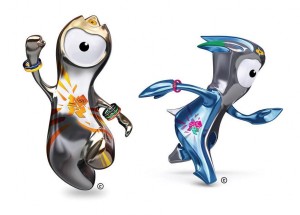Mascot Media: Framing the London Olympics
 After the Vancouver Olympics in 2010, the Antenna editors called for reflections on the memorable events and news frames from the Winter Games (March 5, 2010). Starting the ball rolling, a “pet peeve” for Jonathan Gray was the savaging that the organization of the Games received from the British press, what seemed at the time “a desperate attempt to set the bar as low as possible for the upcoming London Games.” In the spirit of equity, it should be noted that the British press has been just as happy to savage the organization of the London Games, a journalistic sport that pre-dates Vancouver and has been particularly acute in discussions of LOCOG’s branding efforts.
After the Vancouver Olympics in 2010, the Antenna editors called for reflections on the memorable events and news frames from the Winter Games (March 5, 2010). Starting the ball rolling, a “pet peeve” for Jonathan Gray was the savaging that the organization of the Games received from the British press, what seemed at the time “a desperate attempt to set the bar as low as possible for the upcoming London Games.” In the spirit of equity, it should be noted that the British press has been just as happy to savage the organization of the London Games, a journalistic sport that pre-dates Vancouver and has been particularly acute in discussions of LOCOG’s branding efforts.
As we approach the London 2012 Games, it is worth reflecting on the promotional paratexts that surround the Games, as these are often, too easily, mocked or dismissed in ways that do not sufficiently account for the complexities of promotional design work, or the way that texts such as logos and mascot films amplify clusters of meaning and expectation around media events. The London mascots, Wenlock and Mandeville, have been a particular subject of press criticism since their unveiling in 2010 – two sleek CGI characters distinguished by a huge cyclopean camera-eye. Generating revenue through toy licensing deals, the mascots have also been designed to embody the digital address of the Olympics, inviting children to interact with their “Olympic journey” through virtual encounters on Twitter, Facebook, and an interactive website. While their alien look has led to some very un-childlike descriptions within international media coverage – Vanity Fair calling Wenlock a “ghoulish cycloptic phallus,” the Toronto Sun describing the mascots as “walking penis monsters,” and Twitter postings labelling them “terror sperm” – Wenlock and Mandeville are a deliberate departure from the history of cuddly Olympic mascots first embodied by the cartoon bear Misha at the 1980 Moscow Olympics and carried through to Beijing’s Fuwa mascots. Phallic fears notwithstanding, they assume the appearance of high-tech toys born from – and for – a digital world.
Like the graffiti design of the London 2012 logo, which also received a press drubbing when unveiled in 2007, Wenlock and Mandeville have been given a deliberate multimedia inscription. This is captured in a series of animated mascot films released periodically in the UK leading up to the Games. Viewable online, on British children’s channels such as CBBC, as well as in film theatres, the film shorts began with Out of a Rainbowin May 2010 and have been followed by Adventures on a Rainbow (March 2011), Rainbow Rescue (December 2011), and Rainbow to the Games (May 2012). Animated by the Chinese digital media firm Crystal CG, these films reveal interesting networks of production. In industry terms, the mascot films are the result of multi-level collaboration taking place between British and Chinese creative personnel. While the shorts were written, produced, directed, narrated, and scored by British artists, much of the animation production was completed in Crystal’s offices in London and Beijing, highlighting the rise of Chinese digital expertise in the media industry sub-sector of promotional design.
Textually, the animated shorts serve a particular brand function in the UK, selling the Games as a participatory national event and identifying a diverse and youth-friendly selection of British Olympians as its sporting face. The shorts also, importantly, develop a narrative of media engagement, anticipating the Olympics through mobile screens and social networking sites aimed specifically at children. The liquid design of Wenlock and Mandeville and the use of mobile phones and SMS messaging within the narrative arc of the mascot films both reinforce the digital identity of the London Olympics. While UK factories are figured in the mascot films as central to building the physical infrastructure of the Games, the meaning of the Olympics is vested in the mobile, data-driven world of the mascots. While the new media aesthetic of the logo and mascots has come under fire – one media critic labelling Wenlock and Mandeville “appalling computerised smurfs for the iPhone generation” – the entryway paratexts of London 2012 are more interesting than these sniffy descriptions suggest. Not least, they reveal the changing way that media brands, including the Olympics, are seeking to reconstruct themselves for the converged digital media environment. To what extent the London Games lives up to aspirations of being the first digital Olympics, and whether the mascot films become mere fig-leaves for impending organizational pratfalls, remains to be seen.



Great post and interesting to think about the ways in which these promotional texts attempt to mobilise a particular digital identity to the games through their narrative and aesthetic. I’m interested in the relationship between the digital identity of the London Olympics and the rhetorical address to the metaphor of ‘England’s green and pleasant land’, which is more apparent in the later mascot films and seems to be emphasised in what has been revealed of the opening ceremony set that focuses on the green pastures of the UK. It will be interesting to see how the digital identity of the London Olympics games plays out (no pun intended!) in relation to this more pastoral vision of Britain.